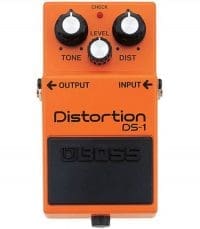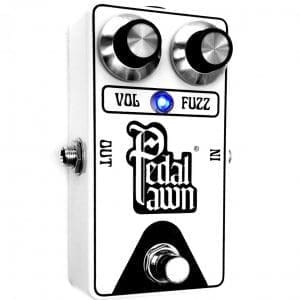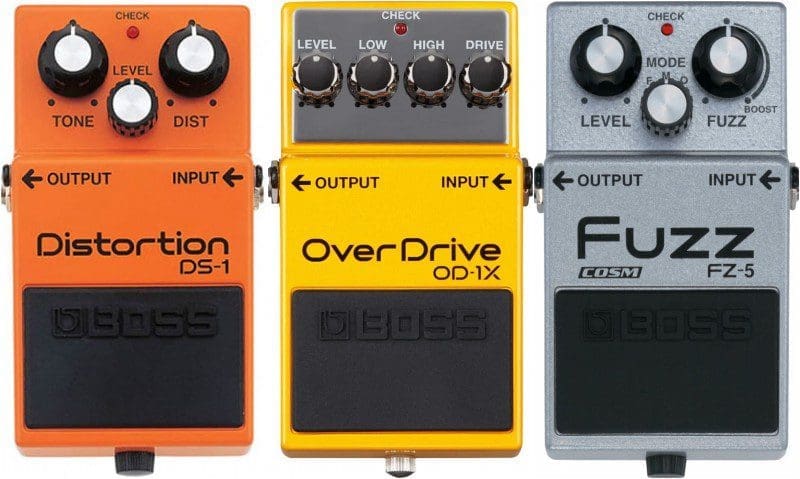Last update 5/2/2024
Distortion, in context to the electric guitar. A specific type of tone is often described as “gritty,” growling, or ballsy. It’s usually achieved by high-gain settings on an amp. The opposite of distortion is referred to as a “clean” or low gain tone.
Table of contents
Distortion pedals are designed to allow the player to dial in the type of distortion desired. For most players, the level of distortion is key to their overall tone. A distorted guitar sound is a crucial component for many genres like rock, blues, metal, acid, and punk, to mention a few.
Distortion Pedals Buying Guide – What’s the difference between overdrive, distortion, and fuzz?
Technically, all three of these guitar effects fall under the distortion category. Depending on the type of clipping, “overdrive,” “distortion,” and “fuzz” are names given to different distortion types.
Distortion is a broad term, and the types of distortion that commonly describe it are as follows.
Classic Distortion


Considered the “traditional distortion,” it is achieved through hard clipping. However, the process is almost the same as with overdrives. This harder clipping produces a harsher or “scorched” kind of tone.
This type of clipping produces more harmonic content. Not to get too geeky about it. We could say that more boosted “overtones” with each sound you make with your distortion turned on.
This makes classic distortion an excellent choice for lead sections or power chords. Playing more than two or three notes simultaneously might sound a bit “muddy.”
Overdrive


Overdrive is the distortion effect created by soft clipping. The tone of an overdrive pedal is usually softer and more subtle than classic distortion.
Contrary to what some guitar players might think, it’s not a distortion with a low gain setting. This amp emulates the sound of old-fashioned tube amps pushed to their limits.
Overdrive pedals are usually common among blues guitarists, although they find their way into any style or song requiring a softer yet distorted tone.
Fuzz


Finally, fuzz is produced through extreme clipping. Fuzz pedals boost your signal more and then cut it abruptly, resulting in a “square”-shaped wave. In a way, it sounds like a broken amplifier and features a lot of harmonic content. Some fuzz pedals also add a bottom octave to the original note that you’re playing.
Fuzz pedals are a bit tricky. It helps play single-note solos and riffs—Especially in psychedelic and stoner rock genres. You can also play power chords or fourth intervals with it. However, anything else could sound messy.
Let’s get fuzzy; first, start with the clean signal. We can represent it graphically as one continuous sine curve. So it goes up and down like a constant rollercoaster. It has its peak-to-peak amplitude and its wavelength.
If you amplify the signal, the amplitude gets bigger. However, every device that you play through has its limitations. The smooth sine curve is cut or “clipped when the limits are reached.” As a result, you get distortion.
The effect can also be heard on malfunctioning or overloaded hi-fi devices. But the result is used by musicians and music producers. It’s most popular among guitar players.
“I’ve always wanted to smash a guitar over someone’s head. You just can’t do that with a piano.” Elton John
We mentioned that every device has its limitations. “Headroom” refers to the maximum signal strength these devices can provide without clipping.
Ok, So What Is “Boost” Then?


What about those “boost” or “clean boost” pedals? These are designed to boost your original signal’s amplitude without clipping it.
There are two ways you can implement them.
They can serve as a simple volume boost without changing the color of your tone. Your guitar will get louder in the overall mix, which can be helpful for lead sections.
You can also use them to boost your signal before entering a tube amp. This way, your guitar amplifier creates all the distortion “organically” by using its limitations.
What Distortion Devices Do to a Guitar Signal
So, how do distortion pedals and other guitar-oriented devices work in practice? In the old days, tube amps were the only devices among guitar players that could quickly achieve distortion. This was due to having very little headroom. As a result, you could notice more distortion at higher-volume settings and implement different playing dynamics.
The idea behind guitar distortion pedals (or any other formats, like rack-mounted units) is to boost the signal and deliberately clip it. For this purpose, we have operational amplifiers, transistors, and diodes.
Operational amplifiers are also known as “op-amps.” They are devices that amplify the guitar’s clean signal. The signal that goes into the pedal is boosted (its peak-to-peak amplitude is increased). However, the limitations of a distortion pedal are set using transistors or diodes. These are different devices, but they both create types of clipping that enhance your tone from a practical perspective.
Furthermore, Another way to achieve distortion is to use preamp tubes, like 12AX7s or ECC83s. Some pedals implement them to create distortion.
Soft, Hard, and Extreme Clipping
Guitar players can differentiate clipping into three types: soft, hard, and extreme. This refers to the shape of the curve as it’s being cut. Soft clipping means that the continuous sine curve of the clean signal is cut more gradually as it hits the limitations of a device.
On the other hand, hard clipping cuts off the sine curve more aggressively. There’s a sudden cut and a sudden “release” when the signal goes back in the limitations of a pedal’s or amp’s headroom.
Lastly, we have extreme clipping, which ultimately morphs the original signal. The sine curve turns into a square, which impacts the sonic output. Signals are pushed harder into devices and are then aggressively clipped or cut off.
Types of clipping will determine the three basic distortion types. Of course, other factors can further change and fine-tune the distortion. For instance, symmetrical and asymmetrical clipping and different transistor types exist.
In Conclusion
So yeah, using distortion is all about finding your own tone. You don’t have to use it all the time, right? Clean tones, when appropriate, are also part of your overall tone; there are no rule books to abide by.
Here are a few tips to help you get started:
- Start with a low gain setting and increase it gradually until you find the desired level of distortion.
- Experiment with different types of distortion pedals to find the sound that you like best.
- Try using distortion pedals in combination with other effects, such as delay, reverb, and chorus, to create unique and interesting sounds.
- Distortion is one of the most versatile and powerful guitar effects available. It can be used to create a wide range of sounds, from mild overdrive to all-out metal distortion. You can find the perfect distortion with a little experimentation.
And remember, as we have already said, “there are no rules” when it comes to distortion. Finding the correct distortion is vital to an electric guitar player’s tone. Invest some time in finding “your tone”: go for it.
Transparency disclosure: Some of the links in this post are affiliate links, meaning that I may earn a commission if you click on a link and make a purchase. This commission comes at no extra cost to you. We only recommend products and services that I believe are helpful and valuable, and we never let the potential for a commission influence our recommendations.
Amazon distortion effects



